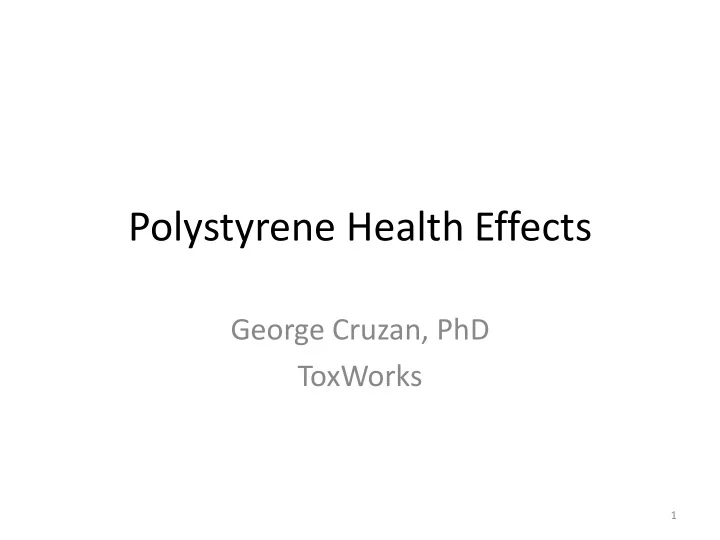

Polystyrene Health Effects George Cruzan, PhD ToxWorks 1
Incorrect Statement • “polystyrene…....is a suspected human carcinogen.” • Polystyrene in NOT a suspected carcinogen • It should not be confused with styrene 2
Are You Confused ? • Polystyrene is a solid; styrene is a liquid • Polystyrene is unreactive; styrene is reactive 3
Chemical Reactions • When chemicals react, the product has its own properties, not those of reactants. • Example Sodium – very reactive solid metal Chlorine – poisonous gas When sodium reacts with chlorine, table salt is produced (sodium chloride) 4
Polymers Differ from Monomers • Polymers do not have the same properties as the monomers that compose them. • Example Glucose – sweet tasting Polymerize by joining glucose molecules together, Produces cellulose – wood or plant fiber • Same for styrene and polystyrene 5
Sources of Styrene Exposure • Ambient air (autombile exhaust, factory discharge, cigarette smoking, etc) – 80 ug/day • Naturally occurring in foods – 9 ug/day • Migration from polystyrene food packaging – 6.6 ug/day – Migration from foam food service items – 4 ug/day ( of the 6.6 ug/day for all PS) • 4 ug = 1millionth of a teaspoon 6
Styrene Health Effects • US NTP (2011) lists styrene as “Reasonably Anticipated to be a Human Carcinogen” – Based on suggestive increases in reinforced plastic workers – Based on lung tumors in mice – No other tumors increased in mice – No tumors increased in rats 7
New Human Studies • Since ROC listing, most human cohorts (groups of workers) have been re-examined as older workers have died • Tumors suggested among earlier evaluations are no longer increased 8
Mouse Lung Tumors • 55 of 70 (78%) normal mice had preneoplastic or neoplastic lesions in lung after lifetime (2 years) exposure to 120 ppm styrene by inhalation. • 0 of 70 mice without CYP2F2 had lung lesions 9
Mode of Action • Key Events – Metabolism by CYP2F2 – No evidence of genotoxicity – Metabolites damage and kill some lung cells – Metabolites stimulate production of new lung cells – Increased cells produce hyperplasia (excessive cells lining airways) – In some mice, tumors develop 10
• Normal metabolism of styrene is catalyzed by CYP2E1 – produces styrene oxide • Mouse lung – CYP2F2 metabolizes styrene to different metabolites – oxidation of aromatic ring • Styrene oxide is not toxic to mouse lung cells without further CYP2F2 metabolism 11
Not toxic CYP2E1 CYP2F2 CYP2F2 Styrene Styrene oxide CYP2F2 Toxic CYP2F2 4-Hydroxystyrene 4-Hydroxystyrene oxide 12
Summary of MOA • Lung tumors in mice, not in rats • Lung toxicity in mice, not in rats • Toxicity and metabolism in Club (Clara) cells in mice, not rats • Lung toxicity from 4HS in mice, not rats • Elimination of lung toxicity from styrene and SO in CYP2F2-KO mice • 80% reduction on ring-oxidized metabolites in CYP2F2-KO mice • Lower level of CYP2F4 in rats does not produce toxicity • Greater lung toxicity in mice from 4HS than from SO • Limited toxicity from 4HS in 2F2-KO mice • 3- or 4-methylstyrene do not cause lung tumors in mice • Enhanced expression of cell cycle genes in WT mice • No enhanced gene expression from styrene in KO mice 13
Human Relevance of Mouse Lung Tumors • Rats have less CYP2F than mice; no toxicity, no lung tumors • Humans have less CYP2F than rats; no toxicity no lung tumors 14
Risk Assessment • Reinforced plastics workers – 2,000,000 ug/day • Ambient styrene – 80 ug/day • Food-derived styrene – 9 ug/day • Polystyrene food service styrene – 4 ug/day • Total non-occupational exposure – 96 ug/day • Banning ps foodservice reduces styrene exposure by less than 5% 15
Risk Assessment • “ Let me put your mind at ease right away about polystyrene foam*” … [the levels of styrene from polystyrene containers] “are hundreds if not thousands of times lower than have occurred in the occupational setting...In finished products, certainly styrene is not an issue.” Linda Birnbaum, Director NTP, 2011. • "The risks, in my estimation, from polystyrene are not very great. It's not worth being concerned about." John Bucher, Associate Director NTP, 2011. 16
Conclusion • Very high exposures to styrene may or may not present a risk • USEPA acceptble exposure 20,000 ug/day; exposure from PS 4 ug/day – 5000-fold safety factor • No government agency considers PS to be carcinogenic • Styrene from polystyrene products do not present a measurable risk. 17
Recommend
More recommend